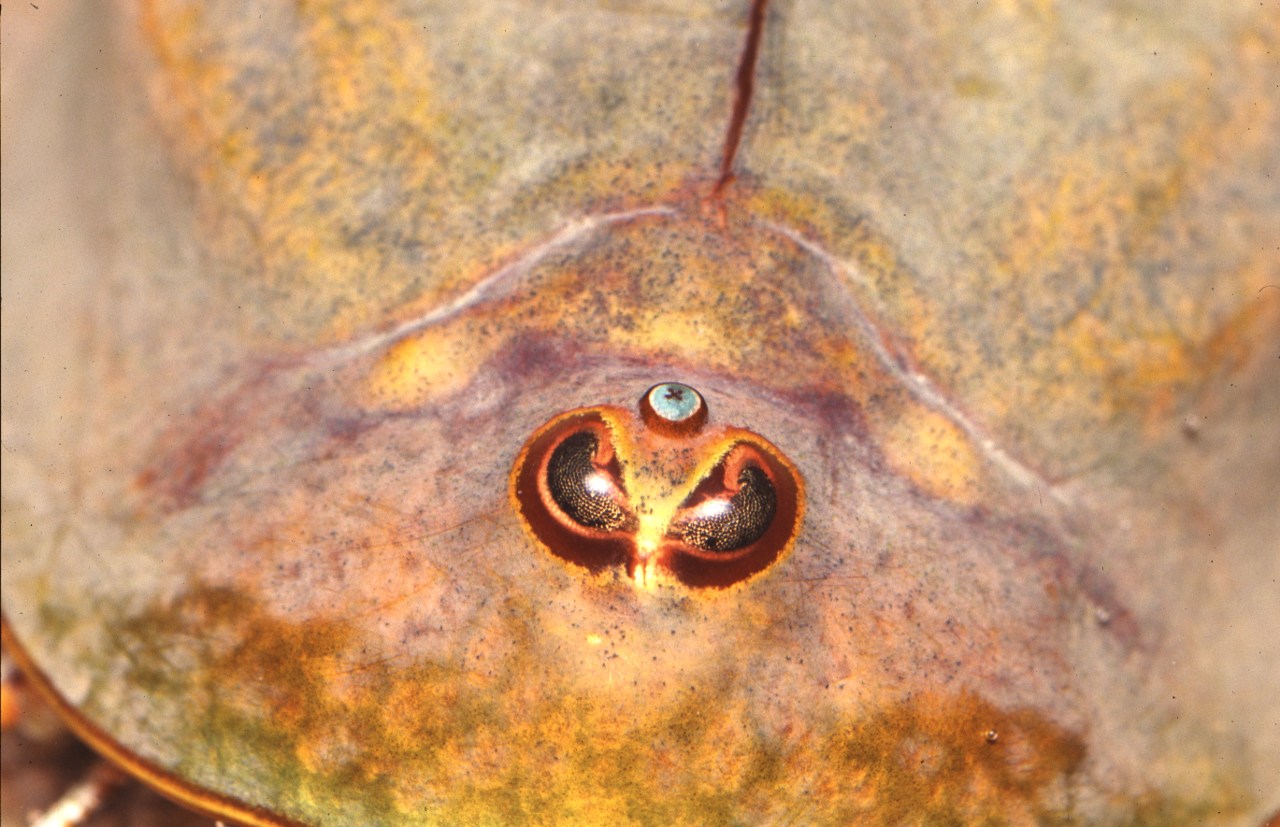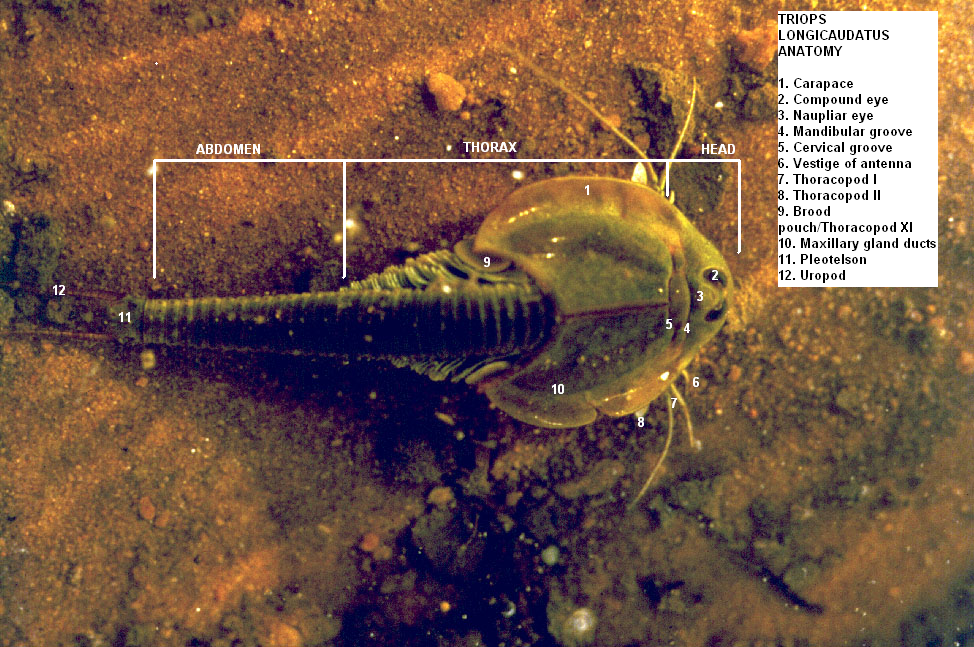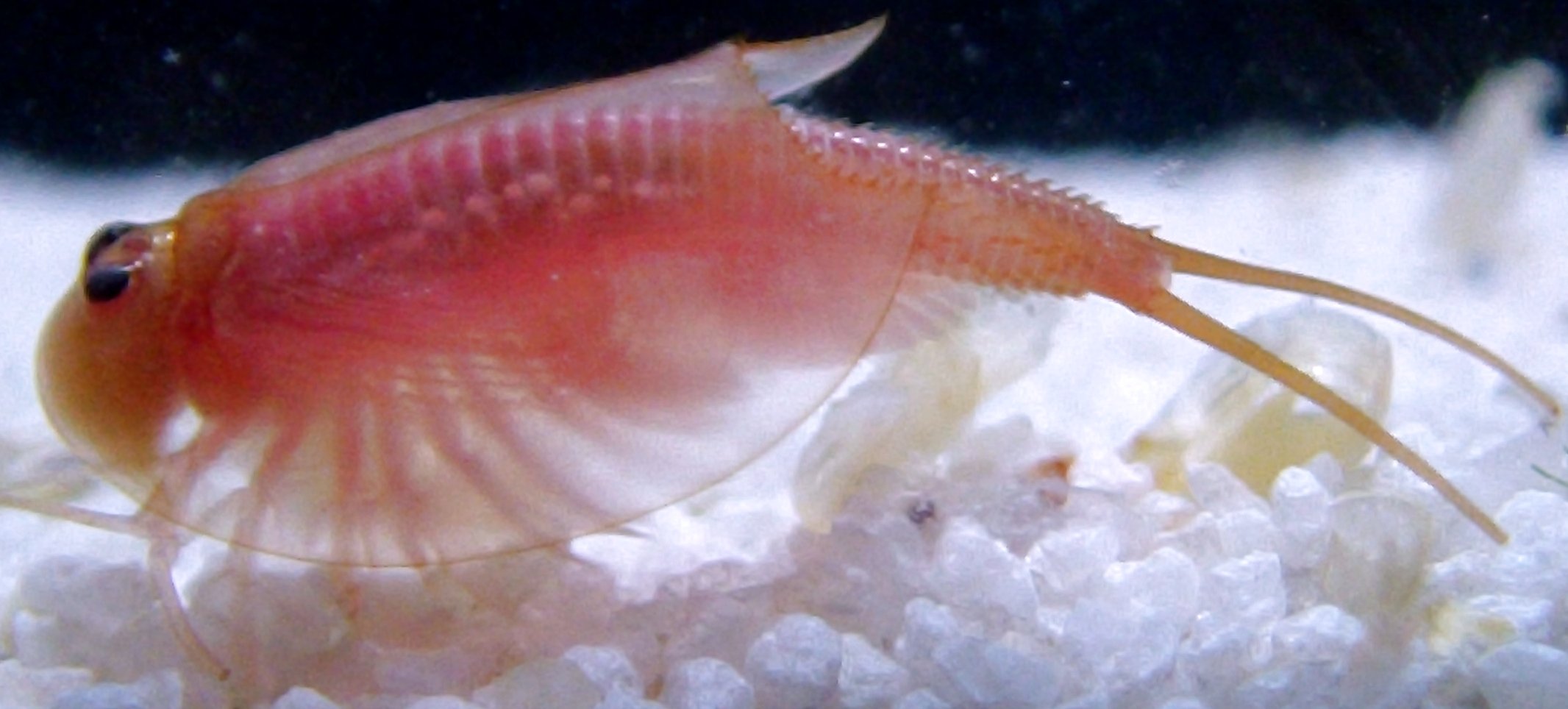|
Triops
''Triops'', from Ancient Greek τρία (''tría''), meaning "three", and ὄψ (''óps''), meaning "face" or "eye", is a genus of small crustaceans in the order Notostraca (tadpole shrimp). The long-lasting resting eggs of several species of ''Triops'' are commonly sold in kits as pets. The animals hatch upon contact with fresh water. Most adult-stage ''Triops'' have a life expectancy of up to 90 days and can tolerate a pH range of 6 to 10. In nature, they often inhabit temporary pools. Relatives and fossil record The genus ''Triops'' can be distinguished from the only other living genus of Notostraca, ''Lepidurus'', by the form of the telson (the end of its 'tail'), which bears only a pair of long, thin caudal extensions in ''Triops'', while ''Lepidurus'' also bears a central platelike process. Only 24 hours after hatching they already resemble miniature versions of the adult form. ''Triops'' are sometimes called "living fossils", since fossils that have been attributed t ... [...More Info...] [...Related Items...] OR: [Wikipedia] [Google] [Baidu] |
Triops Longicaudatus
''Triops longicaudatus'' (commonly called American tadpole shrimp or longtail tadpole shrimp) is a freshwater crustacean of the order Notostraca, resembling a miniature horseshoe crab. It is characterized by an elongated, segmented body, a flattened shield-like brownish carapace covering two thirds of the thorax, and two long filaments on the abdomen. ''Triops longicaudatus'' is found in fresh water ponds and pools, often in places where few higher forms of life can exist. Classification ''Triops longicaudatus'' is a member of the crustacean class Branchiopoda, which primarily contains freshwater animals with gills on their legs. The class Branchiopoda is divided into the subclasses Sarsostraca, containing fairy shrimp, and Phyllopoda, containing all other members (cladocerans, clam shrimps, and the Notostraca, tadpole shrimp). The subclass name, literally meaning ''leaf-footed'', is derived from their flat, leaflike appendages. Notostracans are placed in the infraclass Calamanos ... [...More Info...] [...Related Items...] OR: [Wikipedia] [Google] [Baidu] |
Triops Cancriformis
''Triops cancriformis'', European tadpole shrimp or tadpole shrimp is a species of tadpole shrimp found in Europe to the Middle East and India. Due to habitat destruction, many populations have recently been lost across its European range, so, the species is considered endangered in the United Kingdom and in several European countries. In captivity they commonly grow up to ; in the wild they can achieve sizes of . In the UK, there are just two known populations: in a pool and adjacent area in the Caerlaverock Wetlands in Scotland, and a temporary pond in the New Forest. The species is legally protected under Schedule 5 of the Wildlife and Countryside Act 1981 (as amended). In the past, fossils from the Lower Triassic of France and Upper Triassic of Germany have been attributed to this species, with some even described as specimens of the subspecies ''T. c. minor'', but later research reassigned all of these Triassic specimens to different extinct taxa of uncertain taxonomi ... [...More Info...] [...Related Items...] OR: [Wikipedia] [Google] [Baidu] |
Notostraca
The order Notostraca, containing the single family Triopsidae, is a group of crustaceans known as tadpole shrimp or shield shrimp. The two genera, ''Triops'' and ''Lepidurus'', are considered living fossils, with similar forms having existed since the end of the Devonian, around 360 million years ago. They have a broad, flat carapace, which conceals the head and bears a single pair of compound eyes. The abdomen is long, appears to be segmented and bears numerous pairs of flattened legs. The telson is flanked by a pair of long, thin caudal rami. Phenotypic plasticity within taxa makes species-level identification difficult, and is further compounded by variation in the mode of reproduction. Notostracans are omnivores living on the bottom of temporary pools and shallow lakes. Description Notostracans are long, with a broad carapace at the front end, and a long, slender abdomen. This gives them a similar overall shape to a tadpole, from which the common name ''tadpole shrimp'' derive ... [...More Info...] [...Related Items...] OR: [Wikipedia] [Google] [Baidu] |
Triops Granarius
''Triops granarius'' is a species of tadpole shrimp with a broad distribution from Africa and the Middle East to China and Japan, although there are indications that it, as presently defined, is a species complex. They have elongated bodies and large flaps. ''Triops granarius'' can be kept as pets in home aquaria. Their life expectancy is up to 90 days, and in that time they can grow more than 6 cm in length. ''Triops granarius'' range in colour from dark brown to a light brown with a greenish tinge. They can live in water with a pH from 6 to 10, but the optimal pH is from 7 to 8. Unlike most ''Triops'' species, males make up 40% of the population of this species. Males can be distinguished by their dark shade. ''Triops granarius'' lives in shallow pools or ponds and can survive for days without food, they can eat most organic matter such as detritus and plant debris. ''Triops granarius'' is exposed to desiccation and extreme temperatures after the water dries up in its habi ... [...More Info...] [...Related Items...] OR: [Wikipedia] [Google] [Baidu] |
Triops Australiensis
''Triops australiensis'', sometimes referred to as a shield shrimp, is an Australian species of the tadpole shrimp ''Triops''. Distribution ''Triops australiensis'' has a wide distribution across Australia, excluding the northernmost parts of Western Australia, and Queensland. It is also absent from Tasmania in the south, where it is replaced by ''Lepidurus apus''. The two species can be distinguished by the presence of a supra-anal plate between the caudal rami at the end of the abdomen in ''L. apus'', which is lacking in ''T. australiensis''. Biology ''T. australiensis'' inhabits temporary pools of water in the arid regions of the Australian outback. When desiccated pools fill with water, the resting eggs hatch into nauplii, and rapidly develop to adulthood. Reproduction succeeds within a few weeks of hatching. Adults achieve a maximum size of around , which is considered large for a tadpole shrimp. Water chemistry ''Triops australiensis'' can tolerate a pH of 7–9, a ... [...More Info...] [...Related Items...] OR: [Wikipedia] [Google] [Baidu] |
Triops Newberryi
''Triops newberryi'' is a species of ''Triops'' found on the western coast of North America, commonly in valleys throughout the states of Washington, Oregon, California, and small areas of Nevada, Utah, New Mexico, and Mexico, with at least one disjunct population in Kansas. They are found in vast numbers though in the Coachella Valley in California. ''T. newberryi'' has been reported to have potential as a biocontrol agent for larval mosquitoes breeding in seasonally-flooded habitats. ''T. newberryi'' is genetically distinct from '' T. longicaudatus'', the dominant species in the Central United States. In captivity Though ''Triops newberryi'' is the species most likely to be encountered in the wild on the west coast of North America, it is far less common than '' Triops cancriformis'' and ''Triops longicaudatus ''Triops longicaudatus'' (commonly called American tadpole shrimp or longtail tadpole shrimp) is a freshwater crustacean of the order Notostraca, resembling a miniatur ... [...More Info...] [...Related Items...] OR: [Wikipedia] [Google] [Baidu] |
Triops Gadensis
''Triops gadensis'' is a European species of arthropod in the genus ''Triops'', that belongs to the family of Triopsidae. ''Triops gadensis'' are omnivores and in the wild they mainly eat algae and protozoa; larger ''Triops gadensis'' that are about in length feed on detritus (worms if they can find any), plant fibres and tiny crustaceans such as ostracods or copepods. However when food sources are scarce they will cannibalize each other. These crustaceans swim by drag swim power, which is a method of swimming that all ''Triops'' use. Conservation Status ''Triops gadensis'' is listed as "Endangered" by the IUCN. It is restricted to just 9 locations in southern Spain. The species is affected by pesticide contamination and habitat fragmentation Habitat fragmentation describes the emergence of discontinuities (fragmentation) in an organism's preferred environment (habitat), causing population fragmentation and ecosystem decay. Causes of habitat fragmentation include geologi ... [...More Info...] [...Related Items...] OR: [Wikipedia] [Google] [Baidu] |
Triops Mauritanicus
''Triops mauritanicus'' is a species of tadpole shrimp, found in Southern Spain and Morocco. This species of ''Triops'' can grow to and can be expected to live for 90-120 days on average. This species can be usually found in arid areas and are sometimes sold in kits (although ''Triops longicaudatus'' is the most commonly sold triops ''Triops'', from Ancient Greek τρία (''tría''), meaning "three", and ὄψ (''óps''), meaning "face" or "eye", is a genus of small crustaceans in the order Notostraca (tadpole shrimp). The long-lasting resting eggs of several species of '' ...). Subspecies This species is divided into two subspecies: * ''Triops mauritanicus mauritanicus'' * ''Triops mauritanicus simplex'' References Notostraca Animals described in 1921 {{Branchiopoda-stub ... [...More Info...] [...Related Items...] OR: [Wikipedia] [Google] [Baidu] |
Triops Emeritensis
''Triops emeritensis'' is a species of branchiopod within the family Triopsidae. The species is endemic to the Iberian Peninsula in Extremadura, only being recorded from two ponds near La Albuera, Badajoz. The species has been assessed as 'Critically endangered' by the IUCN Red List, as despite its temporary ponds being in a protected area it still faces potential threats such as nearby agriculture and water extraction, along with habitat fragmentation Habitat fragmentation describes the emergence of discontinuities (fragmentation) in an organism's preferred environment (habitat), causing population fragmentation and ecosystem decay. Causes of habitat fragmentation include geological proces ... from human infrastructure and natural barriers. References {{Taxonbar, from=Q49620285 Crustaceans described in 2010 Notostraca IUCN Red List critically endangered species Critically endangered biota of Europe Fauna of the Iberian Peninsula Fauna of Spain Freshwater crusta ... [...More Info...] [...Related Items...] OR: [Wikipedia] [Google] [Baidu] |
Living Fossil
A living fossil is a Deprecation, deprecated term for an extant taxon that phenotypically resembles related species known only from the fossil record. To be considered a living fossil, the fossil species must be old relative to the time of origin of the extant clade. Living fossils commonly are of species-poor lineages, but they need not be. While the body plan of a living fossil remains superficially similar, it is never the same species as the remote relatives it resembles, because genetic drift would inevitably change its chromosomal structure. Living fossils exhibit punctuated equilibrium, stasis (also called "bradytely") over geologically long time scales. Popular literature may wrongly claim that a "living fossil" has undergone no significant evolution since fossil times, with practically no molecular evolution or Morphology (biology), morphological changes. Scientific investigations have repeatedly discredited such claims. The minimal superficial changes to living foss ... [...More Info...] [...Related Items...] OR: [Wikipedia] [Google] [Baidu] |
Triops Baeticus
''Triops baeticus'' is a species of crustacean of the genus ''Triops'' described by Korn in 2010. It is found in freshwater in parts of both Spain and Portugal. It is considered to be an endangered species by the IUCN The International Union for Conservation of Nature (IUCN) is an international organization working in the field of nature conservation and sustainable use of natural resources. Founded in 1948, IUCN has become the global authority on the status ..., mostly due to habitat fragmentation and pollution. References Notostraca Crustaceans described in 2010 {{Branchiopoda-stub ... [...More Info...] [...Related Items...] OR: [Wikipedia] [Google] [Baidu] |



